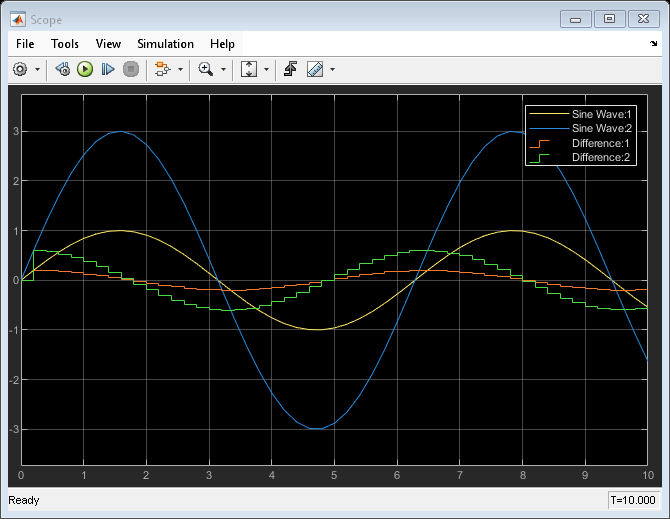Difference
计算一个时间步内的信号变化
库:
Simulink /
Discrete
描述
Difference 模块输出当前输入值减去上一输入值的差值。
示例
端口
输入
输入信号,指定为标量、向量、矩阵或 N 维数组。
依赖关系
当您将输入处理设置为列作为通道(基于帧) 时,输入信号必须有两个或更少的维度。
数据类型: half | single | double | int8 | int16 | int32 | int64 | uint8 | uint16 | uint32 | uint64 | Boolean | fixed point
输出
当前输入减去上一个输入,指定为标量、向量、矩阵或 N 维数组。
数据类型: half | single | double | int8 | int16 | int32 | int64 | uint8 | uint16 | uint32 | uint64 | Boolean | fixed point
参数
常设
为上一个输入设置初始条件。
编程用法
参数:ICPrevInput
|
| 类型:字符向量 |
| 值:标量 | 向量 | 矩阵 | N 维数组 |
默认值:'0.0'
|
指定模块是执行基于采样还是基于帧的处理:
列作为通道(基于帧) - 将输入信号的每一列视为一个单独的通道(基于帧的处理)。
注意
基于帧的处理需要具有 DSP System Toolbox™ 许可证。
有关详细信息,请参阅Sample- and Frame-Based Concepts (DSP System Toolbox)。
元素作为通道(基于采样) - 将输入信号的每个元素视为一个单独的通道(基于采样的处理)。
可以使用输入处理指定模块是执行基于采样的处理还是基于帧的处理。有关这两种处理模式的详细信息,请参阅Sample- and Frame-Based Concepts (DSP System Toolbox)。
编程用法
模块参数:InputProcessing |
| 类型:字符向量 |
值:'Columns as channels (frame based)' | 'Elements as channels (sample based)' |
默认值:'Elements as channels (sample based)' |
信号属性
软件检查的输出范围的下限值。
软件使用最小值执行下列操作:
某些模块的参数范围检查(请参阅指定模块参数的最小值和最大值)。
定点数据类型的自动定标。
从模型生成的代码的优化。此优化可删除算法代码,并影响某些仿真模式(如 SIL 或外部模式)的结果。有关详细信息,请参阅使用指定的最小值和值进行优化 (Embedded Coder)。
提示
输出最小值不会对实际输出信号进行饱和处理或截断。请改用 Saturation 模块。
编程用法
要以编程方式设置模块参数值,请使用 set_param 函数。
| 参数: | OutMin |
| 值: | '[]' (默认) | scalar in quotes |
软件检查的输出范围的上限值。
软件使用最大值执行下列操作:
某些模块的参数范围检查(请参阅指定模块参数的最小值和最大值)。
定点数据类型的自动定标。
从模型生成的代码的优化。此优化可删除算法代码,并影响某些仿真模式(如 SIL 或外部模式)的结果。有关详细信息,请参阅使用指定的最小值和值进行优化 (Embedded Coder)。
提示
输出最大值不会对实际输出信号进行饱和处理或截断。请改用 Saturation 模块。
编程用法
要以编程方式设置模块参数值,请使用 set_param 函数。
| 参数: | OutMax |
| 值: | '[]' (默认) | scalar in quotes |
指定输出数据类型。可以将其设置为:
继承数据类型的规则,例如继承: 通过反向传播继承
内置数据类型的名称,例如
single数据类型对象的名称,例如
Simulink.NumericType对象计算结果为数据类型的表达式,例如
fixdt(1,16,0)
数据类型助手可帮助您设置数据属性。要使用数据类型助手,请点击  。有关详细信息,请参阅使用数据类型助手指定数据类型。
。有关详细信息,请参阅使用数据类型助手指定数据类型。
依赖关系
当输入是小于单精度的浮点数据类型时,继承: 从内部规则继承输出数据类型取决于 Inherit floating-point output type smaller than single precision 配置参数的设置。当对数据类型进行编码所需的位数小于对单精度数据类型编码所需的 32 位时,数据类型小于单精度。例如,half 和 int16 小于单精度。
编程用法
参数:OutDataTypeStr
|
| 类型:字符向量 |
值:'Inherit: Inherit via internal rule' | 'Inherit: Inherit via back propagation' | 'double' | 'single' | 'int8' | 'uint8' | 'int16' | 'uint16' | 'int32' | 'uint32' | 'int64' | 'uint64' | 'boolean' | 'fixdt(1,16)' | 'fixdt(1,16,0)' | 'fixdt(1,16,2^0,0)' | '<data type expression>' |
默认值:'Inherit: Inherit via internal rule'
|
选择此参数可防止定点工具覆盖您在模块上指定的输出数据类型。有关详细信息,请参阅Use Lock Output Data Type Setting (Fixed-Point Designer)。
编程用法
要以编程方式设置模块参数值,请使用 set_param 函数。
| 参数: | LockScale |
| 值: | 'off' (默认) | 'on' |
当您选中此复选框时,溢出将饱和处理为数据类型可表示的最大值或最小值。否则,溢出将绕回。
如果选中此复选框,饱和将应用于模块中的每个内部操作,而不仅仅应用于输出或结果。一般情况下,代码生成进程可以检测到何时不可能发生溢出。在这种情况下,代码生成器不会生成饱和代码。
编程用法
模块参数:DoSatur |
| 类型:字符向量 |
值:'off' | 'on' |
默认值:'off' |
模块特性
扩展功能
代码生成器不会在生成的代码中将构成非原子封装子系统模块的原始模块显式组合在一起。这种灵活性可以提高代码生成效率。在某些情况下,通过选择“视为原子单元”选项,可以通过将封装子系统模块配置为以原子单元执行来进行组合。
HDL Coder™ 提供影响 HDL 实现和综合逻辑的额外配置选项。
此模块具有一个默认 HDL 架构。
| ConstrainedOutputPipeline | 通过移动设计中现有延迟的方式来放置在输出端的寄存器的数量。分布式流水线不会重新分发这些寄存器。默认值为 |
| InputPipeline | 要在生成的代码中插入的输入流水线阶段数。分布式流水线和受限输出流水线可以移动这些寄存器。默认值为 |
| OutputPipeline | 要在生成的代码中插入的输出流水线阶段数。分布式流水线和受限输出流水线可以移动这些寄存器。默认值为 |
PLC 代码生成
使用 Simulink® PLC Coder™ 生成结构化文本代码。
定点转换
使用 Fixed-Point Designer™ 设计和仿真定点系统。
版本历史记录
在 R2006a 之前推出
MATLAB Command
You clicked a link that corresponds to this MATLAB command:
Run the command by entering it in the MATLAB Command Window. Web browsers do not support MATLAB commands.
选择网站
选择网站以获取翻译的可用内容,以及查看当地活动和优惠。根据您的位置,我们建议您选择:。
您也可以从以下列表中选择网站:
如何获得最佳网站性能
选择中国网站(中文或英文)以获得最佳网站性能。其他 MathWorks 国家/地区网站并未针对您所在位置的访问进行优化。
美洲
- América Latina (Español)
- Canada (English)
- United States (English)
欧洲
- Belgium (English)
- Denmark (English)
- Deutschland (Deutsch)
- España (Español)
- Finland (English)
- France (Français)
- Ireland (English)
- Italia (Italiano)
- Luxembourg (English)
- Netherlands (English)
- Norway (English)
- Österreich (Deutsch)
- Portugal (English)
- Sweden (English)
- Switzerland
- United Kingdom (English)

